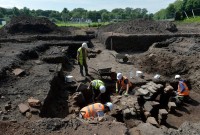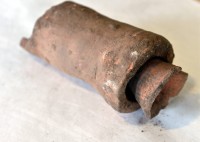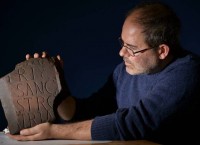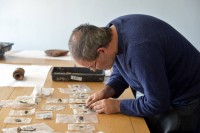 An archaeological survey at the Carlisle Cricket Club’s Edenside ground has discovered the remains of an extraordinarily important Roman bathhouse and dozens of artifacts. Archaeology contractors Wardell Armstrong were called in to survey the site of a proposed new floodproof pavilion, expecting to find little more than random fill dumped during the construction of the nearby Hardwicke Circus roundabout. Instead, they unearthed entire rooms from the ancient bathhouse, intact floors, the remains of a hypocaust system, terracotta water pipes, coins, arrowheads, hair pins, painted tiles and fragments of cooking pots including one with a handsome pouring spout in the shape of a lion’s head.
An archaeological survey at the Carlisle Cricket Club’s Edenside ground has discovered the remains of an extraordinarily important Roman bathhouse and dozens of artifacts. Archaeology contractors Wardell Armstrong were called in to survey the site of a proposed new floodproof pavilion, expecting to find little more than random fill dumped during the construction of the nearby Hardwicke Circus roundabout. Instead, they unearthed entire rooms from the ancient bathhouse, intact floors, the remains of a hypocaust system, terracotta water pipes, coins, arrowheads, hair pins, painted tiles and fragments of cooking pots including one with a handsome pouring spout in the shape of a lion’s head.
 This was a military bathhouse, used by the elite Ala Petriana cavalry regiment. The 1,000-strong garrison was stationed at the Roman fort of Uxelodunum (later known as Petriana after the regiment it housed) on Hadrian’s Wall. It was the largest regiment on the wall manning the largest fort on the wall. The Ala Petriana was a highly prestigious regiment — its members were all granted Roman citizenship for valour on the field — and despite its remote location at the northernmost frontier of the empire, their fort had all the upscale amenities the cream of the Roman cavalry might expect.
This was a military bathhouse, used by the elite Ala Petriana cavalry regiment. The 1,000-strong garrison was stationed at the Roman fort of Uxelodunum (later known as Petriana after the regiment it housed) on Hadrian’s Wall. It was the largest regiment on the wall manning the largest fort on the wall. The Ala Petriana was a highly prestigious regiment — its members were all granted Roman citizenship for valour on the field — and despite its remote location at the northernmost frontier of the empire, their fort had all the upscale amenities the cream of the Roman cavalry might expect.
Today whatever is left of the former fort lies underneath the Carlisle suburb of Stanwix, but very little of it has been excavated because it has been so extensively overbuilt.
“This site is highly significant,” said [Wardell Armstrong technical director Frank] Giecco.
“We’re just beneath the site of the Roman fort at Stanwix and, until now, we never knew where the fort’s bath-house was. The obvious place was near the river. There are blackened areas, probably where they had the furnaces for burning wood to heat the water.
“There were 1,000 men based here, members of the prestigious Ala Petriana and they were paid more than the other soldiers stationed here. The bath-house was a very important part of life for these cavalrymen – a meeting place and there would have been a lot of gambling and coins lost.”
 One notable artifact is a carved sandstone block bearing an inscription with a tribute to Julia Domna, mother of Emperor Caracalla and an able administrator, philosopher, and cultural leader with great hair. Born in Homs, Syria, a city that has been tragically brutalized in the ongoing civil war, to a noble priestly family, she married the future emperor Septimius Severus who showered her with honors including Mater Castorum (mother of the camp or army), Mater Augustus (mother of Augustus, i.e., the Emperor) and Mater Senatus et Patriae (mother of the Senate and fatherland). She was so indispensable to her husband that he took her with him on his military campaign in Caledonia in 208. She was with him when he died in York in 211. Carlisle is just 40 miles northwest of York. It’s not clear to me whether the inscription dates to the reign of Caracalla alone (he was his father’s co-emperor from 198 until 211, becoming sole emperor after he had his brother Gaeta killed that same year and reigning until his own assassination in 217 A.D.). Archaeologists say the inscription was dedicated by her son, but the honorifics on the inscription referring to her as mother of Augustus predate Septimius Severus’ death, so that’s not dispositive; moreover, Caracalla led several incursions north of the Antonine Wall in the last two years of his father’s life, so we know he was in the area when his father still reigned.
One notable artifact is a carved sandstone block bearing an inscription with a tribute to Julia Domna, mother of Emperor Caracalla and an able administrator, philosopher, and cultural leader with great hair. Born in Homs, Syria, a city that has been tragically brutalized in the ongoing civil war, to a noble priestly family, she married the future emperor Septimius Severus who showered her with honors including Mater Castorum (mother of the camp or army), Mater Augustus (mother of Augustus, i.e., the Emperor) and Mater Senatus et Patriae (mother of the Senate and fatherland). She was so indispensable to her husband that he took her with him on his military campaign in Caledonia in 208. She was with him when he died in York in 211. Carlisle is just 40 miles northwest of York. It’s not clear to me whether the inscription dates to the reign of Caracalla alone (he was his father’s co-emperor from 198 until 211, becoming sole emperor after he had his brother Gaeta killed that same year and reigning until his own assassination in 217 A.D.). Archaeologists say the inscription was dedicated by her son, but the honorifics on the inscription referring to her as mother of Augustus predate Septimius Severus’ death, so that’s not dispositive; moreover, Caracalla led several incursions north of the Antonine Wall in the last two years of his father’s life, so we know he was in the area when his father still reigned.
 The excavations were done on the quiet over the past few weeks to avoid drawing unwanted attention from looters. The site and a selection of artifacts were opened to the public on Friday afternoon so visitors could see the finds and the archaeologists at work. Now all the portable finds have been removed and the remains are being covered with a protective membrane. What happens going forward has yet to be decided. The Carlisle Cricket Club still wants to build their pavilion, but have no desire to screw with this nationally important find. They plan to work with the city council to figure out how to have their pavilion without damaging or obscuring the Roman bathhouse remains. See-through floor, man. All the cool kids from Iceland to Turkey to Rome are doing it.
The excavations were done on the quiet over the past few weeks to avoid drawing unwanted attention from looters. The site and a selection of artifacts were opened to the public on Friday afternoon so visitors could see the finds and the archaeologists at work. Now all the portable finds have been removed and the remains are being covered with a protective membrane. What happens going forward has yet to be decided. The Carlisle Cricket Club still wants to build their pavilion, but have no desire to screw with this nationally important find. They plan to work with the city council to figure out how to have their pavilion without damaging or obscuring the Roman bathhouse remains. See-through floor, man. All the cool kids from Iceland to Turkey to Rome are doing it.
“The archaeology they’ve found here is absolutely stunning,” said Carlisle City Council leader Colin Glover. “It’s a fantastic site. It’s been a dream for a long time to find Roman archaeology in Carlisle that is good enough to show to the public.
“We’ve already found lots of good Roman artefacts elsewhere in Carlisle and much of it is at Tullie House Museum where it helps tell the story of Roman Carlisle. […]
“This is something we can do something with long-term. We want to work closely with the cricket club to make the best of this exciting discovery. There are also discussions that we can have with the Heritage Lottery Fund. It’s really exciting to see a place and artefacts that Romans were using in this city almost 2,000 years ago.
“It would be wonderful if we could develop something long-term just a 10-minute walk from the city centre.”
There’s a mini-tour of the hypocaust system and a good shot of the inscribed sandstone fragment in this ITV news story. The following brief Cumberland News video has some good wider views of the excavation.